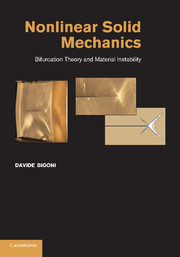Book contents
- Frontmatter
- Contents
- Preface
- Foreword by Giulio Maier
- 1 Introduction
- 2 Elements of tensor algebra and analysis
- 3 Solid mechanics at finite strains
- 4 Isotropic non-linear hyperelasticity
- 5 Solutions of simple problems in finitely deformed non-linear elastic solids
- 6 Constitutive equations and anisotropic elasticity
- 7 Yield functions with emphasis on pressure sensitivity
- 8 Elastoplastic constitutive equations
- 9 Moving discontinuities and boundary value problems
- 10 Global conditions of uniqueness and stability
- 11 Local conditions for uniqueness and stability
- 12 Incremental bifurcation of elastic solids
- 13 Applications of local and global uniqueness and stability criteria to non-associative elastoplasticity
- 14 Wave propagation, stability and bifurcation
- 15 Post-critical behaviour and multiple shear band formation
- 16 A perturbative approach to material instability
- References
- Index
- Plate section
3 - Solid mechanics at finite strains
Published online by Cambridge University Press: 05 August 2012
- Frontmatter
- Contents
- Preface
- Foreword by Giulio Maier
- 1 Introduction
- 2 Elements of tensor algebra and analysis
- 3 Solid mechanics at finite strains
- 4 Isotropic non-linear hyperelasticity
- 5 Solutions of simple problems in finitely deformed non-linear elastic solids
- 6 Constitutive equations and anisotropic elasticity
- 7 Yield functions with emphasis on pressure sensitivity
- 8 Elastoplastic constitutive equations
- 9 Moving discontinuities and boundary value problems
- 10 Global conditions of uniqueness and stability
- 11 Local conditions for uniqueness and stability
- 12 Incremental bifurcation of elastic solids
- 13 Applications of local and global uniqueness and stability criteria to non-associative elastoplasticity
- 14 Wave propagation, stability and bifurcation
- 15 Post-critical behaviour and multiple shear band formation
- 16 A perturbative approach to material instability
- References
- Index
- Plate section
Summary
Kinematics and motion of a solid body are introduced. Mass balance and the concept of force and stress are provided, with emphasis on the notion of work-conjugated stress and strain measures, fundamental in the constitutive description of materials. Rules governing the changes of field quantities for rigid-body rotations of the reference and current configurations are given evidence to clarify the concept of spatial and material fields.
The description of the motion, deformation and stress of a solid body subject to external actions is the focus of solid mechanics, a science that was initiated more than four centuries ago by G. Galilei (1564–1642). Solid mechanics is articulated into five main parts: (1) kinematics and the concept of deformation, (2) mass conservation, (3) forces and stress, (4) the constitutive equations and (5) the setting of the boundary value problem. We will be concerned in this chapter with the preceding points (1) through (3), whereas constitutive equations and the setting of the boundary value problem will be deferred to chapters 4 and 6 through 9. As a complement to the material that will be presented in this chapter, we suggest the exhaustive treatments by Truesdell and Noll (1965), Truesdell (1966), Chadwick (1976), Gurtin (1981), Ogden (1984), and Podio Guidugli (2000).
Kinematics
Bodies occupy configurations, which are regions of the three-dimensional Euclidean point space. Obviously, a body should not be confused with its configuration, for the same reason that the center-line of a cantilever beam should not be confused with the points occupied by the elastica.
- Type
- Chapter
- Information
- Nonlinear Solid MechanicsBifurcation Theory and Material Instability, pp. 125 - 151Publisher: Cambridge University PressPrint publication year: 2012



